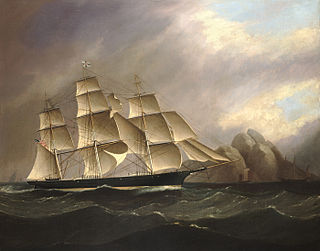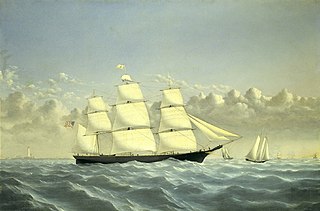
Donald McKay was a Canadian-born American designer and builder of sailing ships, famed for his record-setting extreme clippers.

Champion of the Seas was the second largest clipper ship destined for the Liverpool, England - Melbourne, Australia passenger service. Champion was ordered by James Baines of the Black Ball Line from Donald McKay. She was launched 19 April 1854 and was abandoned 3 January 1877, off Cape Horn.

Marco Polo was a three-masted wooden clipper ship, launched in 1851 at Saint John, New Brunswick. She was named after Venetian traveler Marco Polo. The ship carried emigrants and passengers to Australia and was the first vessel to make the round trip from Liverpool in under six months. Later in her career, the ship was used as a cargo ship before running aground off Cavendish, Prince Edward Island, in 1883.

Lightning was a clipper ship, one of the last really large clippers to be built in the United States. She was built by Donald McKay for James Baines of the Black Ball Line, Liverpool, for the Australia trade.

When launched in 1853, Great Republic was the largest wooden ship in the world. She shared this title with another American-built ship, the steamship Adriatic. She was also the largest full-rigged ship ever built in the United States. She was built by Donald McKay for trade on his own account to Australia.

James Baines was a passenger clipper ship completely constructed of timber in the 1850s and launched on 25 July 1854 from the East Boston shipyard of the famous ship builder Donald McKay in the United States for the Black Ball Line of James Baines & Co., Liverpool. The clipper was one of the few known larger sailing ships rigged with a moonsail.

Red Jacket was a clipper ship, one of the largest and fastest ever built. She was also the first ship of the White Star Line company. She was named after Sagoyewatha, a famous Seneca Indian chief, called "Red Jacket" by settlers. She was designed by Samuel Hartt Pook, built by George Thomas in Rockland, Maine, and launched in 1853, the last ship to be launched from this yard.

The Young America was built by William H. Webb of New York. She was launched in 1853, at the height of the clipper construction boom. She sailed in the California trade, on transatlantic routes, and made voyages to Australia and the Far East.

Carrier Dove was an 1855 medium clipper. She was one of two well-known clippers launched in Baltimore that year, the other being Mary Whitridge.

Ocean Telegraph was a clipper ship that was built in Massachusetts in 1854 and was last known of in Gibraltar in 1923. She was in US ownership until 1863, when UK interests bought her and renamed her Light Brigade.

Golden West was an 1852 extreme clipper built by Paul Curtis. The ship had a very active career in the California trade, the guano trade, the coolie trade, the Far East, and Australia. She made a record passage between Japan and San Francisco in 1856.

Comet was an 1851 California clipper built by William H. Webb which sailed in the Australia trade and the tea trade. This extreme clipper was very fast. She had record passages on two different routes: New York City to San Francisco, and Liverpool to Hong Kong, and beat the famous clipper Flying Dutchman in an 1853 race around the Horn to San Francisco.

During the Australian gold rushes, starting in 1851, significant numbers of workers moved from elsewhere in Australia and overseas to where gold had been discovered. Gold had been found several times before, but the colonial government of New South Wales had suppressed the news out of the fear that it would reduce the workforce and destabilise the economy.
Herald of the Morning was a three-masted square-rigged sailing ship, built in 1853 or 1854 at Saint John, New Brunswick, Canada, expressly for the Australia run. The contemporary Melbourne press described her as 'a fine ship of 1292 tons register'

The SS Schomberg was a clipper built in Aberdeen by Alexander Hall & Co. for "the Black Ball line" for carrying large cargoes and steerage passengers, and to "outdo the Americans". When built, she was regarded as the most luxurious and well-built clipper of the period.
Romance of the Sea was a clipper ship launched in 1853. She was "the last extreme clipper ship built by Donald McKay for the California trade". Her original figurehead was "a small female figure, intended to represent Romance, with the name of [Sir Walter] Scott on one side, and [James Fenimore] Cooper on the other - the greatest romancers of the century". She lost that figurehead during a storm on her third voyage. Some time later it was replaced by "a full-length figure of an ancient navigator, with head bent forward and right hand raised to shade his eyes as he searched for the land beyond the horizon."

Glory of the Seas was a clipper ship launched in 1869. She was the last merchant sailing vessel built by Donald McKay.
The Pomona was a fast packet clipper ship constructed in 1856 for Howland and Frothingham. She operated for just over two and a half years transporting emigrants and cargo from Liverpool, England to New York City. Pomona sank in the early morning of April 28, 1859 after a navigation error caused the ship to strike the Irish coast. 424 of the 448 people on board died.
Santa Claus was an American medium clipper ship built in Boston by Donald McKay in 1854. In the course of her career, she made three voyages from the East Coast of the United States to San Francisco, California, the fastest of which was a comparatively swift 128-day passage in the winter of 1857–1858. The ship was mainly engaged in the guano trade and in trade to the Far East. In 1858, she brought Chinese immigrants to California; according to one source, she was also at one time engaged in the coolie trade.















